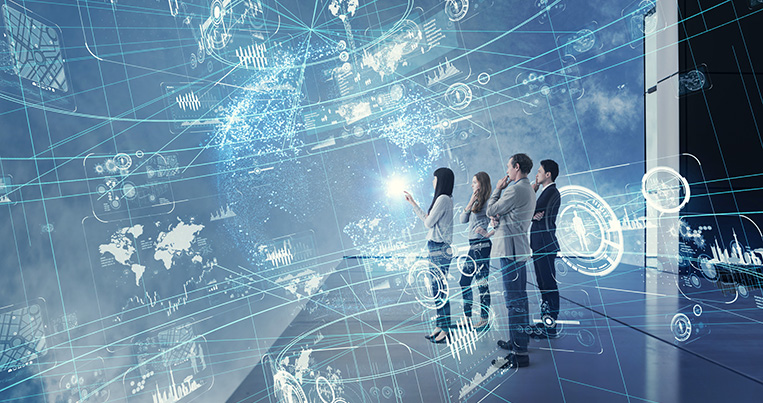AI and the Human Workplace: Evolving Opportunities in Changing Times
Changing technology has been impacting the workplace for decades, but current changes are coinciding with profound changes in the workforce that are affecting us now and will continue to do so well into the future.
Welcome to the Intelligence Revolution
Changing technology is the biggest driving force for human resources since the Industrial Revolution, according to Stephen Harrington, National Lead, Talent Strategy at Deloitte and co-author of Deloitte’s 2017 report, “The Intelligence Revolution.”

Stephen Harrington
Part of the reason for such an impact, he says, is the non-traditional talent or work formats that are increasingly common today—what people call the “gig economy,” in which organizations hire contractors or consultants or farm out work and hire fewer full-time regular employees.
“HR needs to expand its idea of the employment market to include new categories and capabilities. There is the opportunity for automation to come into what we’ve classically thought of as white-collar roles, but we still need humans,” Harrington says. “HR needs to expand its thinking about what it means to deploy capability—some contracting, moving whole functions outside the organization, how to use freelancers—and how to take advantage of that and move smoothly between automation, employees and the gig economy.”
Automating Tasks, Not Jobs
That said, HR professionals don’t need to become deep experts in technology, Harrington notes. The whole concept of the job itself is changing. Technology isn’t automating jobs, it’s automating tasks, freeing up more time for humans to spend creating value.

Gord Orlikow, CPHR
Gord Orlikow, CPHR, senior client partner at Korn Ferry, agrees. “Technology, automation, AI—they’re all a continuation of trends we’re already seeing,” he says, “but the acceleration of the trends over the last 20 years has been pervasive.”
Technology can now support the flexible workforce and the gig economy, he adds.
“As we develop more sophisticated algorithms, certain functions are more subject to replacement by technology —administrative ones such as payroll and benefits. But some areas are more insulated from the impact. In employee relations, we still need people sitting across the table negotiating an agreement,” says Orlikow. “We still need humans for creativity, judgement and empathy. Only repetitive jobs are being lost. It began on the factory floor and not it’s moved into the financial economy. It’s pervasive even in jobs that we would have thought weren’t susceptible.”
Awareness Is the Starting Point
According to the Deloitte report, “Awareness is the starting point for collaboration, innovation and action.”
There seems to be a clear need for further awareness. In its worldwide survey of C-suite business executives and HR leaders, Deloitte’s 2017 Human Capital Trends Report found that only 40 per cent saw robotics, cognitive computing and AI as an important trend.
The same report found that 41 per cent of companies had already fully implemented or made significant progress in adopting cognitive and AI technologies in their workforce, laving 59 per cent who don’t understand its importance or potential.
For many HR practitioners, the first job at hand is to understand what technology is in the marketplace now and how it can or will impact their work.
Impacting the Work Day
Christina Seargeant, CPHR is senior HR business partner at Workday, a technology company that builds HR applications and tools.

Christina Seargeant, CPHR
“There’s so much in the way of automation. In talent management, you can use technology to find people to tag as successors by analyzing their skills and capabilities. They’re easily identified and mapped, ” says Seargeant. “For talent acquisition, we can manage the recruiting life cycle digitally. And instead of disparate systems that don’t talk to each other, with data in different places, current technology makes it all-in-one.
And while technology can definitely help in seeking out suitable candidates and engaging them, she says, but it also has a significant role to play in retention. “It’s easy to discover new job opportunities within the organization.”
“There’s strong value in telling the story and seeing it all in one view. It’s current, not what was saved weeks ago. It saves you time and enables you to make decisions based on the information that’s up to date and that you can trust,” Seargeant explains. “That can be what sets you apart from your competition, which is important when it’s so easy for people to go elsewhere.”
Enhanced Employee Experience
Internally, and perhaps unsurprisingly, Workday has found technology contributes to communication in a big way.
“Especially for a company like ours, where we have 35-plus offices and nearly 10,000 employees all over the world, the abilities to send instant messages, attach files and start video conferences are crucial,” says Seargeant. “We celebrate people’s expertise and have created a way for them to share it with others in the organization.”
Using Slack, an internal collaboration tool, they’ve just launched peer learning, enabling their workforce to create content and share it with the organization or to crowd-source knowledge. Video resources help employees learn how to use the tools.
Learning management systems can house a lot of learning and development content, Seargeant says, but by making it part of their overall system, it’s now available to employees any time or place.
“By breaking it into bite-sized, digestible pieces, we’ve made it so employees can watch and engage with the content at their own pace. One of the cool features is the video interaction with the content you’re watching, such as quizzes,” Seargeant says.“We can track when people stop or how many do the quizzes—and it’s closed captioned to make it as accessible as possible.”
Letting Robots be Robots has Benefits
In so many ways, the working norm has changed, but while the elevation of the employee experience is seeing its benefits, the proverbial “rise of the robots” has paralleled this process.
Robotic process automation (RPA) is defined as computer-coded software or programs that replace humans performing repetitive, rules-based tasks. They’re cheaper than humans, more accurate and capable of operating 24/7.
The C.D. Howe Institute says its research shows that routine tasks declined by more the 12 per cent in Canada between 1987 and 2015, while non-routine, cognitive tasks increased by more than seven per cent. The Deloitte report notes that this process will accelerate over the next 10 to 15 years—with estimates of the number of jobs susceptible to automation made by three research organizations ranged from 35 to 41.9 per cent.
On the flip side, proponents of automation point out that removing repetitive tasks from people’s jobs will free up employees to do more valuable work.
Moreover, as per the Deloitte report: “The possibility of automating routine tasks and ultimately letting the robots be robots, will allow humans the opportunity to do more human-like work.”
Cobots: Better Business Collaborators To Be
The same report describes cobots, or collaborative robots, as “equipped with sensors and AI tools that enable them to see and feel, allowing them to work closely with humans.”
Also predicted in Deloitte’s future-proofing report? By 2018, 30 per cent of new robotic deployments would be such collaborative robots capable of working side-by-side with human colleagues.
It explains that cobots are designed to work with employees, rather than replace them, by streamlining repetitive tasks and freeing human colleagues to concentrate on more creative, intellectually engaging work that requires uniquely human traits like communication, personal service and strategic decision-making.
“The question for companies is not ‘How many cobots can take the place of traditional employees?” the report concludes, but rather, “‘How can cobots best augment workers to increase employee productivity and engagement?’”
Moving on to Artificial Intelligence
While robotic process automation is here now, Harrington says, AI and its sub-component, learning machines, are only starting to make an appearance. What separates AI from other automation is its capability to learn over time and get better, he explains.

Norah Joyce
The most fully-developed example of this in the workplace is VedaWork’s Ava, the HR virtual assistant, or as some would say, the Siri of HR. It was developed by a team at Morneau Sheppell that included Paul Sywulych, partner, enterprise innovation, and Norah Joyce, partner.
“If you want to ask questions about a restaurant or make reservations for dinner, you go to Siri, Alexa or Google,” Sywulych says. “Why can’t HR work the same way?” People are starting to expect that same capability in their HR departments, he adds.
If employees have questions about pensions or benefits, or want to book time off, change their address or look up their last pay statement, Ava can help them, Sywulych explains. With the ability to install the application on their mobile phones, they no longer need to call HR staff to get answers.
Meet Ava: Your Virtual HR Assistant
Ava was developed in 2017, using IBM’s Watson platform in the back end, and piloted with Morneau Sheppell employees as well as those of some of their clients.
“Ava can hook into your specific data and point to further resources. For example, an employee might ask, ‘How much money is in my pension account?’ Ava can tell them, and then ask, ‘Would you like to hear how those investments break down?’” Sywulych says.
The development team started with a base number of questions, then used their experience with real people to identify patterns that they would prioritize to add next. Ava can answer more than 350 questions now, with more being added all the time. Paul estimates Ava could have the capability to answer ‘what if?’ questions within a few months. They also use a natural language processor that figures out what the question means.
Employee Opinions in Real Time
Ava can also do pulse surveys. If an employee asks about current internal job openings, it could be a hint that they’re not happy where they are. After supplying the requested information, Ava might ask, “Are you happy in your current job?” Or if someone has asked about their benefits, Ava might ask, “By the way, are you satisfied with your benefits?”
It then reports responses anonymously for groups of 20 or more, giving HR real-time data without having to wait for an annual engagement survey.
“Ava is helping HR get more specific data to get in front of business issues,” says Joyce. “We’re using AI to streamline tasks and pull data together.”
Organizations may choose to retain their annual employee survey, Joyce explains, but employees often find it easier to interact with Ava. The questions are asked conversationally, one at a time and when the topic is top of mind for them. The resulting data is also more current.
In addition, organizations can add two targeted questions of employees that require only a one-sentence answer, a yes or no, or perhaps a choice of emojis.
Helping HR Do More
“There are business issues that HR can help drive, through what they manage,” Norah adds. By streamlining HR services through AI, for example, organizations can save money and provide 24/7 service.
The next step is predictive analysis—for example, predicting turnover.
“We’re using AI to help us predict turnover as a starting point. It’s a big nut that’s not been cracked, and it’s expensive and time-consuming for the business to deal with,“ says Joyce, who knows its worth expressly. “It’s a more engaging experience for employees. Millennials in particular don’t want to pick up the phone and call HR,” she notes. They want to be able to access information when and where they need it, whether it’s in the grocery line after work or when they first wake up in the morning.
Using predictive analysis, organizations can get meaningful information around solving business issues, Joyce says. Ava will be able to identify pockets of pertinent information by location, manager, performance, career opportunities, etc., then target those areas to turn the issue around.
Joyce cites the example of the person who feels their career has stalled. In the old world, they might have been headhunted or moved gone outside the company on their own. With predictive analysis, they might be put in a program that highlights the opportunities available in their own organization and the training needed to access them, getting the individual more involved in their own career planning. It will keep the employee more engaged where they are today.
What’s Coming Next
While Ava is already interactive in terms of looking up information personalized to the user, there is opportunity for more interactivity down the road. It might help an employee create a career plan and goals, then check in on if the person is meeting their goals.
This ties into a three-year road map for Ava’s development, Joyce explains. It’s already streamlining processes and services. Next, its current predictive analysis capabilities will be more fully developed to identify more than staff turnover issues.
The last stage is resolving issues. “This is the least far along,” Norah says. AI will use the knowledge of the issue it has identified to work toward resolution based on the identified drivers.
The above example of personal and career goals is in testing. When it makes sense, Morneau Sheppell will partner with other organizations to complete the function, rather than developing functions that other companies have already researched, developed and tested.
“The key is the link between streamlining, predicting and resolving,” Joyce adds. “It’s the three together that will be most powerful. It comes back to helping employees – it’s what pieces you use to solve their issues.”
Full Circle to Employees
Keep in mind it will still be employees who keep an organization running. “The big challenge will be the transition,” Harrington says. “But if you can’t figure out the jobs of the future, look at which capabilities are least likely to be automated—execution or the ability to get things done, influence, and social awareness.”
Orlikow adds agility, relationship-building and intellectual skills to that list. “They’re unequivocally the best indicators of an individual with the potential for further growth.”
“The media coverage is so much about technology that it doesn’t give people much to go on as far as what to do next or how to prepare,” Harrington continues. “That presents a great opportunity for the role HR can play, to help the workforce lead the discussion about how things are going to be fundamentally different and to help develop a new strategy with the workforce right in the middle of it.”
He believes the most important takeaways from the Deloitte report are that the shift in workforce is happening, it will affect business and the change curve is not likely to plateau any time soon.
While Orlikow agrees that the transition may not be smooth in all cases, he believes the advent of advanced technology and AI offers enormous implications and opportunities for HR. With all the data it will be able to access, it will be able to show just as well as more traditionally data-driven areas how it adds value to the organization from the people side.
“But it’s up to HR to define it, lead it and execute on that,” he says. “HR’s star will never be brighter, but we need to embrace it. It’s a time-limited opportunity; the window will not be open indefinitely. We need to act on it in the next few years.”
“We have the opportunity as Canadian businesses to take seriously our responsibility for our workforce,” concludes Harrington. “Canadian business needs to be proactive in beginning to model the future of the workforce and experiment with technology in those new models.
“That’s the best way to protect our workforce.”
Nancy Painter is an award-winning communication consultant and writer based in Surrey. She is an active member in both the International Association of Business Communicators and the Professional Writers Association of Canada.
(PeopleTalk Summer 2018)









